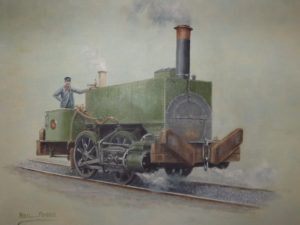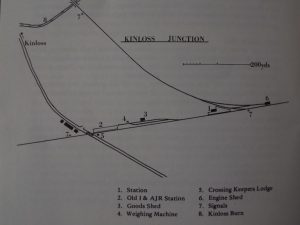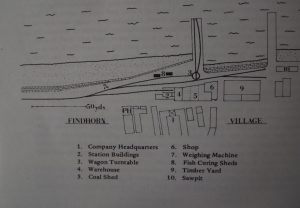This short branch line has the distinction of being one of the first railways in Scotland to close due to lack of traffic. Its first appearance in railway history was in 16th June 1859 at the inaugural meeting of Ordinary Shareholders at Forres Town Hall. Peter Brown, Chairman of the Company regretted that construction of the line would have to be delayed because part of the route ran close to Findhorn Bay and because of this the Admiralty would have to approve the line before construction could commence.
Charles Brand & Sons contractor commenced work on 17th August 1859 with a target date of opening set for January 1860. Reports in the Forres Gazette of 28th September suggested that the opening date would be easily met. This faltered when a hard winter commenced in October with the countryside reaming under a blanket of frost and snow until the end of February 1860.
On 9th April 1860 the Inverness and Aberdeen Junction Railway provided one of their 2-4-0 Seafield Class locomotives “Altyre” to enable Captain H.W. Tyler of the Railway Department to inspect the line. Several faults were found and it was not until these were corrected that the line opened for business on 18th April 1860.
Initial services were three trains per day with services taking 18 minutes to travel between Kinloss and Findhorn. Luggage allowances were generous First Class passengers could take 100llbs of baggage whereas Third Class had to be satisfied with a mere 56llbs. Smoking was banned on all trains and stations. Business was depressing low and during the first four months of service total receipts were £201. 05. 09. with working expenses amounting to £193. 12. 02. any surplus was more than eaten up by interest and loans.
Rolling Stock
The Findhorn Railway had limited funds so had to search around for low cost locomotive and they found this with Neilson & Co. of Glasgow. The engine was one that was primarily designed for industrial use a box tank built in 1859 that even by the standards of the time was an outdated design so it was offered to the Findhorn Railway at a discounted price. Subsequently it was purchased by Highland Railway where under the instruction of William Stroudley it was modernised but still carried the No16 number plate that it was given by the Findhorn Railway. Livery under the ownership of the Findhorn Railway is not known, but in HR service it was dark green. It was used during the construction of the Highland Railway’s Keith to Buckie line and when that job was complete it was sold to Hector McKenzie who used it to build the Sutherland and Caithness Railway, making it the first locomotive to be seen in Wick and Thurso. On completion of that contract it was used to build the Dunfermline & Queensferry Railway. After that railway was completed the rest of the engine’s history is not known.
No goods wagons were owned by the railway, but they were happy to run goods stock from other companies. The company did own a coach that most likely came from Brown Marshall of Birmingham and a brake van, possibly from the same manufacturer.

The only piece of original art that I own shows the Findhorn Locomotive under Highland Railway ownership.
Route of the Railway
Findhorn was considered to be the port for Forres and this was the reason for the construction of the line as it was at one time a significant enterprise having its own merchant fleet of a dozen vessels. Overseas shipping also used Findhorn brining in goods from the continent and returning with agricultural products such as fish and timber. Population of the village continued to grow so the prospects of the line seemed good. However, there was one problem that was missed, the Culbin Sands that the wind was blowing into Findhorn Bay and was starting to silt up the river.
Original plans for the line were that they would start at Forres before turning seaward at Kinloss. By 1859 when the Board of The Findhorn Railway were ready to build their line, the Inverness and Aberdeen Junction Railway had in 1858 already constructed their line from Forres to Elgin. Modification of the Findhorn Railway’s plans saw the use of the Inverness’s Company line to reach Kinloss. Strangely the junction that joined the two lines faced towards Elgin rather than Forres, require much shunting for trains to complete the journey to Findhorn.

There was no engineering obstacles to be overcome in the building of the line a few minor embankments were required to maintain the level of the line an overbridge to cross the Findhorn Burn and two bridges to allow road traffic to cross the line. Level crossings were also required, one at East Longcot Farm and not to be outdone another crossing to give access to West Longcot Farm. As previously mentioned for a good part of the journey the line followed the edge of the river, during the period of the operation of the line just before entering the village a Cholera Hospital was built to the east of the line.
The Terminus of the line consisted of a coal shed, weighting machine, warehouse and a wagon turntable that gave access to two sidings on the pier nearest to the Kinloss end of the railway. Surprisingly there was no run-round loop and this necessitated either rope shunting or the use of a horse to move wagons.

What remains Today
Despite the line being closed in 1869 if you know where to look traces of it are still visible today. Starting at the level crossing on the main line at Kinloss if you look towards the Elgin direction on the left hand side of that railway you will see a line of trees. This was the junction where the Findhorn Railway commenced and was the site on their station. Extensive construction of houses and the building of RAF Kinloss in 1939 wiped out all traces of the railway. All is not lost if you proceed to Findhorn on the B9011 to the left of the entrance to The Findhorn Foundation the track bed of the railway can still be found, now serving as a footpath. The railway again disappears under housing and road developments as the entrance of Findhorn is arrived at. In the village the Company’s headquarters building still exists now serving as flats with the exterior still looking much the same as it did when the railway was operational. A few tumbled down wooden sheds at the Findhorn Bay side mark the spot of the Terminus and although the loading pier still exits there is no trace of the wagon turntable or evidence that rail lines went on to the end of the it.
Modelling Possibilities
Despite seeming like a challenge to build The Findhorn Railway because of its early time period and lack of readily available kits to build its rolling stock, it has been done. A layout built to 7mm featured in two editions of the “Railway Modeller”. Sadly my new found ability to tidy up has resulted in my loss of these to editions of this magazine. If anyone has access to the on-line archive for this periodical perhaps they can supply the information that I have now lost.
By John Ross
